new posts in all blogs
Viewing: Blog Posts Tagged with: Latino/Hispanic/Mexican, Most Recent at Top [Help]
Results 26 - 50 of 55
How to use this Page
You are viewing the most recent posts tagged with the words: Latino/Hispanic/Mexican in the JacketFlap blog reader. What is a tag? Think of a tag as a keyword or category label. Tags can both help you find posts on JacketFlap.com as well as provide an easy way for you to "remember" and classify posts for later recall. Try adding a tag yourself by clicking "Add a tag" below a post's header. Scroll down through the list of Recent Posts in the left column and click on a post title that sounds interesting. You can view all posts from a specific blog by clicking the Blog name in the right column, or you can click a 'More Posts from this Blog' link in any individual post.

By:
rgarcia406,
on 2/19/2015
Blog:
The Open Book
(
Login to Add to MyJacketFlap)
JacketFlap tags:
Diversity 102,
Diversity,
Publishing 101,
Book Lists by Topic,
Uncategorized,
African/African American Interest,
Asian/Asian American,
Awards,
Dear Readers,
Lee & Low Likes,
New Voices/New Visions Award,
Diversity, Race, and Representation,
Race,
Tu Books,
Native American,
Race issues,
Teens/YA,
writing contests,
multicultural books,
aspiring authors,
author advice,
Latino/Hispanic/Mexican,
Add a tag
Getting your book published is difficult, and unfortunately it tends to be much harder when you’re a Person of Color. While there are more diverse books being published, there’s still a lot of work to do!
Fortunately there are awards and grants out there help writers of color achieve their publication dreams.
We’ve created a list of awards and grants to help you get started!
New Voices Award – Established in 2000, is for the unpublished author of color for a picture book manuscript.
 New Visions Award – Modeled after LEE & LOW’s New Voices Award, this award is for Science Fiction, Fantasy, or Mystery middle grade or YA novels.
New Visions Award – Modeled after LEE & LOW’s New Voices Award, this award is for Science Fiction, Fantasy, or Mystery middle grade or YA novels.
SCBWI Emerging Voices Grant – This award is given to two unpublished writers or illustrators from ethnic and/or cultural backgrounds that are traditionally under-represented in children’s literature in America and who have a ready-to-submit completed work for children.
The Angela Johnson Scholarship from Vermont College of Fine Arts – This scholarship is for new students of color of an ethnic minority for VCFA’s MFA program.
Vaunda Micheaux Nelson Scholarship from Hamline College – “Annual award given to a new or current student in the program who shows exceptional promise as a writer of color.”
We Need Diverse Books Short Story Contest - This short story contest was inspired by Walter Dean Myers’ quote, “Once I began to read, I began to exist.”
The Scholastic Asian Book Award – This award is for Asian writers writing books set in Asia aimed at children 6-18 years of age.
Octavia E. Butler Memorial Scholarship Fund – This fund enables writers of color to attend the Clarion writing workshops where writer Octavia Butler got her start.
SLF Diverse Writers and Diverse Worlds Grants – These grants are new works and works in progress. The Diverse Writers Grant focuses on writers from underrepresented and underprivileged backgrounds, and the Diverse Worlds Grant is for stories that best present a diverse world, regardless of the author’s background.
Eleanor Taylor Bland Crime Fiction Writers of Color Award – This one time grant is awarded to an emerging writer of color of crime fiction.
NYFA Artists’ Fellowships – These fellowships are for residents of New York State and/or Indian Nations located in New York State.
Golden Baobab Prizes for Literature – These annual awards recognize emerging African writers and illustrators.
The Sillerman First Prize for African Poets – This prize is for unpublished African poets.
What other awards and grants do you recommend for authors of color?
 Monica Brown is the author of several award-winning
Monica Brown is the author of several award-winning  children’s books, including the Marisol McDonald series, and is a Professor of English at Northern Arizona University. Brown recently spoke to KNAU Public Radio about the power of dehumanizing language after a politician used the word “deportable” to refer to an immigrant. She has allowed us to reprint her comments below, and you can hear her radio segment here:
children’s books, including the Marisol McDonald series, and is a Professor of English at Northern Arizona University. Brown recently spoke to KNAU Public Radio about the power of dehumanizing language after a politician used the word “deportable” to refer to an immigrant. She has allowed us to reprint her comments below, and you can hear her radio segment here:
Deportable. The prefix de signifies removal, separation, reduction or reversal, as in deforestation or demerit. De reverses a verb’s action, as in defuse ordecompose. De is not often used with a noun, but it was last week. That’s when Republican Representative Steve King referred to one of First Lady Michelle Obama’s guests as “a deportable.” He tweeted it.
When I heard this description of 21 year old Ana Zamora, a hardworking college student and DREAMer, it felt like a blow to the chest. When President Obama enacted his 2012 executive order on immigration, Ana Zamora wrote him a thank you letter. She said, “I am finally a person in the United States…”
Not according to Representative King. To him, she is a deportable.
I am a bilingual Latina whose mixed ethnic heritage lets me embrace the multiplicity, complexity and beauty of the Americas, North and 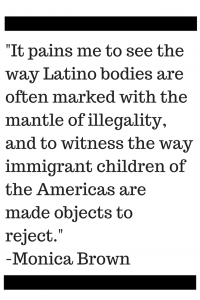 South. It pains me to see the way Latino bodies are often marked with the mantle of illegality, and to witness the way immigrant children of the Americas are made objects to reject, a class of “deportables” if we were to use King’s terminology. I suggest we don’t.
South. It pains me to see the way Latino bodies are often marked with the mantle of illegality, and to witness the way immigrant children of the Americas are made objects to reject, a class of “deportables” if we were to use King’s terminology. I suggest we don’t.
In migrating to the United States, Ms. Zamora’s parents brought with them their dedication to family, hard work, and dreams of a better future for their children. Ms. Zamora is the embodiment of those dreams. Chicana sage Gloria Anzaldua once described the U.S.-Mexico border as a “1,950 mile-long open wound.” It is a place of conflict, confrontation and pain. The term “a deportable” rubs salt in that wound by devaluing and dehumanizing a young woman who represents the very best of our country.
As a professor of English and children’s author, I know words matter. Within my community, an immigrant without documents might be described as “sin papeles.”Without papers. It is a legal status they lack, not who and what they are.
Thankfully, many have come to understand that, in the words of Holocaust survivor Elie Wiesel, “no human being is illegal.” Today I’d like to state, unequivocally, that no human is a deportable, either.
Further Reading
Visit Monica Brown’s website
Purchase Marisol McDonald Doesn’t Match or Marisol McDonald and the Clash Bash

By:
rgarcia406,
on 2/3/2015
Blog:
The Open Book
(
Login to Add to MyJacketFlap)
JacketFlap tags:
Awards,
ALA,
children's books,
Book News,
Uncategorized,
Diversity,
Pat Mora,
Coretta Scott King Award,
Race,
multicultural books,
African/African American Interest,
Dear Readers,
Latino/Hispanic/Mexican,
Lee & Low Likes,
Diversity, Race, and Representation,
Diversity 102,
recap post,
Little Melba,
Little Melba and her Big Trombone,
Arbuthnot Honor,
Día,
Water Rises,
Water Rolls,
Add a tag
Yesterday was the ALA Youth Media Awards, or the “Oscars of Children’s Literature” as they’re sometimes called. It was a big day for diversity. Diverse books and authors were honored across the board and we couldn’t be happier.
Little Melba and Her Big Trombone, written by Katheryn Russell-Brown and illustrated by Frank Morrison, received the Coretta Scott King Honor for Illustration. Little Melba follows the life of famed trombonist, composer, and arranger Melba Liston who broke through racial and gender barriers to become one of the great unsung heroes of jazz.
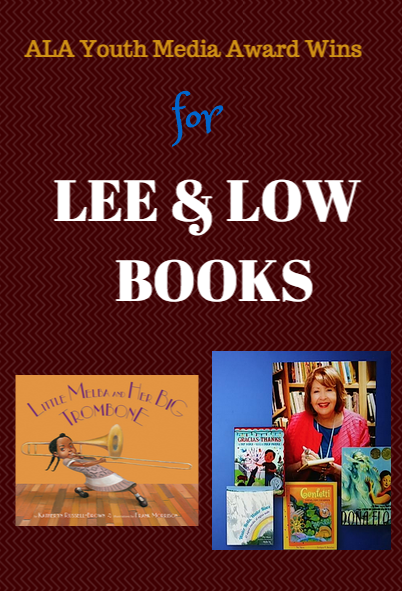
Pat Mora, author of Water Rolls, Water Rises/El agua rueda, el agua sube and many other award-winning titles, won the 2016 May Hill Arbuthnot Honor Lecture Award! This award recognizes an author, librarian, or children’s lecturer who will then present a lecture at a winning host site. In addition to her writing, Pat Mora is also a literacy
advocate. She created Día, a day that celebrates children and the importance of reading.
Congratulations to all the titles honored at the ALA Youth Media Awards!

By:
Jason Low,
on 11/25/2014
Blog:
The Open Book
(
Login to Add to MyJacketFlap)
JacketFlap tags:
diversity,
Educators,
Native American,
African/African American Interest,
Asian/Asian American,
Latino/Hispanic/Mexican,
Diversity, Race, and Representation,
Diversity 102,
Add a tag
 November is Native American Heritage Month, which is as good a time as any to discuss the slight issue we have with observance months. Native American Heritage Month and Black History Month, for example, were established to celebrate cultures that otherwise went ignored, stereotyped, or otherwise underappreciated. Educators often use these months as a reason to pull titles by/about a particular culture off the shelf to share with students.
November is Native American Heritage Month, which is as good a time as any to discuss the slight issue we have with observance months. Native American Heritage Month and Black History Month, for example, were established to celebrate cultures that otherwise went ignored, stereotyped, or otherwise underappreciated. Educators often use these months as a reason to pull titles by/about a particular culture off the shelf to share with students.
While we can generate a recommended reading list just as well as the next publisher, the problem we find with Native American Heritage Month is that it puts Native American books—and people—in a box. The observance month can easily lead to the bad habit of featuring these books and culture for one month out of the entire year. Ask yourself: Have we ever taken this approach with books that feature white protagonists?
On the other hand, observance months can definitely do some good: they remind educators to highlight the achievements of particular cultures, and can make students from those cultures feel acknowledged and appreciated. But wouldn’t it be better if that feeling and effort could be maintained all twelve months of the year?
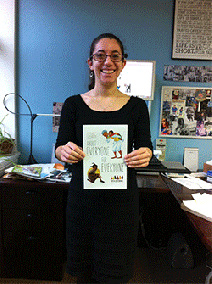
brochure/all inclusive reading poster
For us, featuring diverse books throughout the year is second nature. Our approach is to dig deeper and go beyond just one month. We identify the various ways our books can apply to everyday, universal experiences and communicate this as widely as possible. We developed a ten-step process for becoming a more inclusive reader, part of a brochure that folds out to a poster (see right).
Educators stuck in the heritage month mindset can instead use the recommended book lists for those months as a jumping-off point to permanently diversify their collections. If you use particular books during a heritage month, ask yourself: What other themes does this book touch upon? How can I connect it to other parts of the curriculum or use it to teach additional skills?

Our book Buffalo Song by Joseph Bruchac is often included in roundups and recommendations for Native American Heritage Month. The book is a biography of Walking Coyote, who brought the buffalo herds of the American West back from the brink of extinction. While this book is certainly a good fit for Native American Heritage Month, it can also be used to teach about many other things, such as:
• Environmental conservation
• Nonfiction and biography
• Core values like perseverance and respect
Our literacy specialist even details ways it can be used in conjunction with trips to state and national parks.
Now here’s a challenge for you: Take the books used this month to celebrate Native American Heritage Month and brainstorm ways that they can be used throughout the year. We’d love to hear your thoughts in the comments below.
Filed under:
Diversity 102,
Diversity, Race, and Representation Tagged:
African/African American Interest,
Asian/Asian American,
diversity,
Educators,
Latino/Hispanic/Mexican,
Native American 


By:
rgarcia406,
on 10/28/2014
Blog:
The Open Book
(
Login to Add to MyJacketFlap)
JacketFlap tags:
bilingual books,
multicultural books,
LGBT,
Children's Book Press,
African/African American Interest,
Asian/Asian American,
Latino/Hispanic/Mexican,
Lee & Low Likes,
Activities and Events,
Book Lists by Topic,
Diversity 102,
and Representation,
Add a tag
Today is Mix It Up At Lunch Day, an annual day started by Teaching Tolerance over a decade ago to encourage kindness and reduce prejudice in schools by encouraging students to sit and have lunch with someone new, one day out of the year. Teaching Tolerance offers some great resources to help schools celebrate Mix It Up At Lunch Day, and we thought we’d add our own list of recommended books that encourage kindness, giving, bravery and open-mindedness!
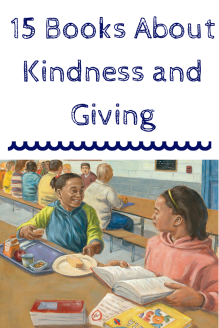
- Lend a Hand: Poems About Giving written by John Frank and illustrated by London Ladd- A collection of poems showing the many ways individuals can make differences.
- Antonio’s Card written by Rigoberto González and illustrated by Cecilia Álvarez – Antonio’s classmates make fun of Leslie, Antonio’s mother’s partner because of her paint-spattered overalls. Antonio decides to make a card for his mother and her partner.
- First Come the Zebra by Lynne Barasch – Abaani, a Maasai boy, sees a Kikuyu boy, Haki, tending a new fruit and vegetable stall alongside the road and they take an immediate dislike to each other. A short while later, a dangerous situation arises near Haki’s stall and Abaani and Haki must overcome their differences and work together.
- King for a Day written by Rukhsana Khan and illustrated by Christiane Krömer – Malik wants to become the king of the kite festival, Basant. Using his kite Falcon, Malik becomes the king of Basant! When he sees a bully take a kite from a girl, Malik uses Falcon to give her a nice surprise.
- Grandfather Counts written by Andrea Cheng and illustrated by Ange Zheng – Gong Gong, Helen’s grandfather who only speaks Chinese, moves in with her family. Helen is worried about not being able to speak to him. She hears him counting train cars in Chinese, and she reciprocates by showing him how to count in English.
- Sam and the Lucky Money written by Karen Chinn and illustrated by Cornelius Van Wright and Ying-Hwa Hu – Sam receives lucky money–red envelopes called leisees (lay-sees), from his grandparents that he can spend any way he wants. When he doesn’t have enough money to buy what he wants, Sam
 instead decides to give his money to a homeless man.
instead decides to give his money to a homeless man.
- Birthday in the Barrio written by Mayra Lazara Dole and illustrated by Tonel – Chavi’s friend Rosario wants to have a quinceñera (sweet 15), but her family can’t afford it. Chavi gathers people in the barrio (neighborhood) and throws Rosario a birthday party in the community center.
- Brothers in Hope written by Mary Williams and illustrated by R. Gregory Christie – When eight-year-old Garang’s village in southern Sudan is destroyed, he walks thousands of miles with many other boys to seek safety. The boys face numerous hardships and dangers along the way, but their faith and mutual support help keep the hope of finding a new home alive in their hearts.
- Destiny’s Gift written by Natasha Anastasia Tarpley and illustrated by Adjoa J. Burrowes – Destiny’s favorite place to be is Mrs. Wade’s bookstore; she helps out every Saturday. When Mrs. Wade tells Destiny she has to close the bookstore, Destiny organizes her community to protest.
 Passage to Freedom written by Ken Mochizuki and illustrated by Dom Lee – Chiune Sugihara, the Japanese diplomat to Lithuania, helped thousands of Jewish people escape the Holocaust by giving them visas to Japan.
Passage to Freedom written by Ken Mochizuki and illustrated by Dom Lee – Chiune Sugihara, the Japanese diplomat to Lithuania, helped thousands of Jewish people escape the Holocaust by giving them visas to Japan.- Goldfish and Chrysanthemums written by Andrea Cheng and illustrated by Michelle Chang – Nancy’s grandmother, Ni Ni, finds out that her childhood home in China is being torn down. After winning two goldfish at the fair, Nancy keeps Ni Ni’s memories of her garden alive by recreating it in their backyard.
- Irena’s Jars of Secrets written by Marcia Vaughan and illustrated by Ron Mazellan – Irena Sendler, a Polish social worker, witnesses the injustices committed against Jewish people in Warsaw during WWII. First, she smuggles things they need into the Warsaw ghetto, and then, using false documents, she smuggles Jewish children out of the ghetto. She keeps jars with their information, hoping to reunite them with their families.
- Puffling Patrol by Ted and Betsey Lewin – Every April, the Westman Islands off the coast of Iceland become home to hundreds of thousands of puffins, small black-and-white seabirds with colorful bills. When the young puffins, called pufflings, are ready to make their way into the sea, they’re helped by the Puffling Patrol, children who help guide the pufflings to the ocean.

- Rent Party Jazz by written William Miller and illustrated by Charlotte Riley-Webb – Rent day is coming, and Sonny’s mama has lost her job. Sonny isn’t sure what to do, but a jazz musician named Smilin’ Jack hosts a party to help Sonny and his mama raise money for their rent.
- Aani and the Tree Huggers written by Jeannine Atkins and illustrated by Venantius J. Pinto – While Aani sits under her favorite tree, she hears men coming in to cut down the trees, despite protest from the women in the village. When the men return to cut the trees, Aani hugs a tree to prevent them from cutting it down, and the rest of the people in her village follow suit, saving the forest.
For more information about Mix It Up at Lunch Day and how to participate, click here!
Filed under:
Activities and Events,
and Representation,
Book Lists by Topic,
Diversity 102,
Lee & Low Likes Tagged:
African/African American Interest,
Asian/Asian American,
bilingual books,
Book Lists by Topic,
Children's Book Press,
Latino/Hispanic/Mexican,
LGBT,
multicultural books 


By:
rgarcia406,
on 10/24/2014
Blog:
The Open Book
(
Login to Add to MyJacketFlap)
JacketFlap tags:
Diversity 102,
diversity news,
news roundup,
movies,
the book of life,
African/African American Interest,
animated films,
Musings & Ponderings,
Latino/Hispanic/Mexican,
Lee & Low Likes,
we need diverse books,
Diversity, Race, and Representation,
dear white people,
Add a tag
Though the weather outside has been dreary, some of this diversity news has been anything but!
 This week, the We Need Diverse Books campaign announced that they’re naming an award in honor of the late, great Walter Dean Myers! They are currently raising money through their IndieGoGo campaign and the hashtag #SupportWNDB.
This week, the We Need Diverse Books campaign announced that they’re naming an award in honor of the late, great Walter Dean Myers! They are currently raising money through their IndieGoGo campaign and the hashtag #SupportWNDB.
School Library Journal and #WNDB also announced their collaboration. The collaboration will include a diversity-themed event at the 2016 ALA Midwinter conference and support for the diversity-themed festival to be held in the Washington, D.C. area in 2016.
We’re also excited to see all of the diverse movies being released:
 The Book of Life, the Mexican-themed fantasy-adventure was released last week! Manolo, an adventurer, travels through magical worlds to rescue his one true love and defend his village from death!
The Book of Life, the Mexican-themed fantasy-adventure was released last week! Manolo, an adventurer, travels through magical worlds to rescue his one true love and defend his village from death!
Dear White People, the comedy-satire that started as a Youtube concept trailer premieres today. Dear White People was the winner of the 2014 Sundance Film Festival’s Special Jury Award for Breakthrough Talent. This comedy is a clever satire of race relations in the age of Obama.
Disney’s next heroine will be Moana. The eponymous film will be about a  teenaged explorer from Oceania who travels the ocean with a demigod named Maui in search of an island. It’s set to be released in 2016!
teenaged explorer from Oceania who travels the ocean with a demigod named Maui in search of an island. It’s set to be released in 2016!
Have you seen any great news about diversity this week?
Filed under:
Diversity 102,
Diversity, Race, and Representation,
Lee & Low Likes,
Musings & Ponderings Tagged:
African/African American Interest,
animated films,
dear white people,
diversity news,
Latino/Hispanic/Mexican,
movies,
news roundup,
the book of life,
we need diverse books 


By:
rgarcia406,
on 10/14/2014
Blog:
The Open Book
(
Login to Add to MyJacketFlap)
JacketFlap tags:
list,
halloween,
diversity,
Joseph Bruchac,
Native American,
Science Fiction/Fantasy,
African/African American Interest,
Multiracial,
Tu Books,
Teens/YA,
Asian/Asian American,
Latino/Hispanic/Mexican,
Diversity in YA,
Lee & Low Likes,
Diversity, Race, and Representation,
Book Lists by Topic,
Add a tag
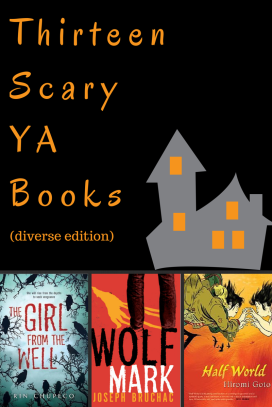
Halloween is right around the corner. There’s no better way to celebrate than by reading books that will scare you to pieces! Here’s a lucky thirteen list of our favorites (all featuring diverse characters or by diverse authors):
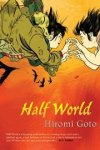 Half World by Hiromi Goto – Melanie Tamaki lives with her mother in abject poverty. Then, her mother disappears. Melanie must journey to the mysterious Half World to save her.
Half World by Hiromi Goto – Melanie Tamaki lives with her mother in abject poverty. Then, her mother disappears. Melanie must journey to the mysterious Half World to save her.- Vodnik by Bryce Moore – Sixteen-year-old Tomas moves back to Slovakia with his family and discovers the folktales of his childhood were more than just stories.
- The Immortal Rules by Julie Kagawa – Allie Sekemoto survives by scavenging for food by day. She hates the vampires who keep humans like cattle for their food. Until the day she dies and wakes up as a vampire.
- Liar by Justine Larbalestier – Micah is a liar; it’s the only thing she’ll tell you the truth about. But when her boyfriend Zach is murdered, the whole truth has to come out.
- Battle Royale by Koushan Takami – A group of junior high school students are sent to an island and forced to fight to the death until only one of them survives.
- Summer of the Mariposas by Guadalupe Garcia McCall – Odilia and her sisters discover a
 dead man’s body while swimming in the Rio Grande. They journey across Mexico to return his body in this Odyssey-inspired tale.
dead man’s body while swimming in the Rio Grande. They journey across Mexico to return his body in this Odyssey-inspired tale.
- Devil’s Kiss by Sarwat Chadda – Zombies, ghouls, and vampires all make appearances in the story of Bilquis SanGreal, the youngest and only female member of the Knights Templar.
- Panic by Sharon Draper – Diamond knows better than to get into a car with a stranger. But when the stranger offers her the chance to dance in a movie, Diamond makes a very wrong decision.
- Ten by Gretchen McNeil – Ten teens head to a secluded island for an exclusive party…until people start to die. A modern YA retelling of Agatha Christie’s And Then There Were None.
- Wolf Mark by Joseph Bruchac – Inspired by the Abenaki skinwalker legend, this YA thriller is Burn Notice with werewolves.
 The Girl from the Well by Rin Chupeco – A dead girl roams the streets, hunting murders. A strange tattooed boy moves to the neighborhood with a deadly secret.
The Girl from the Well by Rin Chupeco – A dead girl roams the streets, hunting murders. A strange tattooed boy moves to the neighborhood with a deadly secret.- 172 Hours on the Moon by Johan Harstad – Three teenagers win the vacation of a lifetime: a week-long trip to the moon. But something sinister is waiting for them in the black vacuum of space.
- Anna Dressed in Blood by Kendare Blake – Cas Lowood is a ghost hunter, called to Thunder Bay, Ontario to get rid of a ghost the locals call Anna Dressed in Blood, who has killed every person who has stepped foot in the house she haunts.
What else would you add to the list?
Filed under:
Diversity in YA,
Diversity, Race, and Representation,
Lee & Low Likes,
Tu Books Tagged:
African/African American Interest,
Asian/Asian American,
Book Lists by Topic,
diversity,
halloween,
Joseph Bruchac,
Latino/Hispanic/Mexican,
list,
Multiracial,
Native American,
Science Fiction/Fantasy,
Teens/YA,
Tu Books 


By:
jilleisenberg14,
on 8/10/2014
Blog:
The Open Book
(
Login to Add to MyJacketFlap)
JacketFlap tags:
children's books,
diversity,
Immigration,
Reading Aloud,
Educators,
reading comprehension,
Race issues,
Educator Resources,
Latino/Hispanic/Mexican,
ELL/ESL and Bilingual Books,
Add a tag
What an amazing week to see the response of last Sunday’s post and hear what many of you are facing, doing, and aspiring to in schools and communities. In addition to using children’s books to initiate conversations, deepen background knowledge, and humanize the events, here are eleven teaching resources to help you provide the best information, context, and perspective for your students.
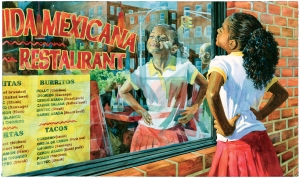
- Colorín Colorado is a free bilingual service that presents information, activities, and advice for educators and Spanish-speaking families of English Language Learners. One of my favorite sections is “Reaching Out to ELL Students and Families” because it gives explicit tools on how to create a welcoming classroom environment, learn about our students’ backgrounds, and reach out to parents of ELLs.
- Educators For Fair Consideration (E4FC) offers educator guides to support teachers and school staff in supporting undocumented students in school and beyond graduation.
- Colorlines contributes award-winning daily reporting, investigative news, and analysis on issues of race with a subsection devoted to child migrants. They also have a campaign, Drop the I-Word.
- The Library of Congress has curated thousands of resources, especially primary sources and online exhibitions, on immigration in the United States providing critical historical context to current events. I strongly recommend checking out the presentation, Immigration: The Changing Face of America, where students can read the immigration history of specific ethnicities and races, and the Themed Resources: Immigration, where students can study the contributions of American immigrants.
- The staff at the Latin American and Iberian Institute (University of New Mexico) have created and organized thematic guides, lesson plans, and news articles for issues related to Latin America available at the Latin America Data Base.
- Teaching Tolerance, a project of the Southern Poverty Law Center, provides award-winning educational materials to teachers, including immigration-themed units and lessons.
- Border Crossers has prepared a list of resources for adults to learn how to teach and talk about race and racial justice with students.
- The Migrant Policy Institute, a Washington, DC think tank, offers powerful analysis of global and regional migration. I want to underscore their visual tools, such as the International Migrant Population by Country of Origin and Destination map.
- Accompanying the two PBS documentary series, Latino Americans and The New Americans, are rich lesson plans and activities for grades 7 and up to explore the diverse experiences of coming to America.
- Latin@s in Kid Lit has an extensive list of children’s literature for those looking for more beyond our eleven book list, as well as interviews and teaching ideas.
- The MY HERO Project enables students to create, share, and discover stories, audio, art, and films that promote tolerance, peace, and diversity. Teacher resources are available at MY HERO Teacher’s Room.
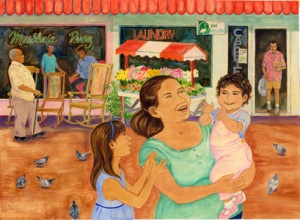 For further reading:
For further reading:
11 Books on Latin American Immigration and Migration
What resources would you add? What resources do you recommend? Please share them with our community in the comments!
Filed under:
Educator Resources,
ELL/ESL and Bilingual Books Tagged:
children's books,
diversity,
Educators,
Immigration,
Latino/Hispanic/Mexican,
Race issues,
Reading Aloud,
reading comprehension 


By:
jilleisenberg14,
on 8/2/2014
Blog:
The Open Book
(
Login to Add to MyJacketFlap)
JacketFlap tags:
children's books,
events,
diversity,
Immigration,
Reading Aloud,
Educators,
reading comprehension,
close reading,
Race issues,
Educator Resources,
Common Core State Standards,
Latino/Hispanic/Mexican,
ELL/ESL and Bilingual Books,
Add a tag
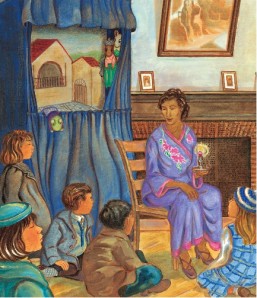 As media coverage has intensified around the events of children crossing the U.S. border, many educators and families are wondering, “What should we tell our students?” For some children, this may be the first time they are learning of these countries. But for many others, these events may involve their own heritage or depict their families’ experiences. Using books to talk about the recent events can be an opportunity to learn about a new region and help children see the cultures and people beyond these events.
As media coverage has intensified around the events of children crossing the U.S. border, many educators and families are wondering, “What should we tell our students?” For some children, this may be the first time they are learning of these countries. But for many others, these events may involve their own heritage or depict their families’ experiences. Using books to talk about the recent events can be an opportunity to learn about a new region and help children see the cultures and people beyond these events.
We’ve put together a list of 11 books (many of which are bilingual English/Spanish) that teach about the emotional journey families and children must undertake along with the physical journey. These stories allow children to see each other and themselves in characters who are living life to the fullest and refusing to let any obstacle stand in their way.
Whether you are looking to explore the themes of the DREAM Act, learn more about the journey of one’s own family, or see America from a different angle, these books reveal the complexities, challenges, joys, and surprises of coming to a new place. Join these characters as they share their challenges and excitement in moving to a new culture and new school, helping their families adjust, and juggling their home culture with a new culture.
 1. A Movie in My Pillow/ Una película en mi almohada
1. A Movie in My Pillow/ Una película en mi almohada
Poet Jorge Argueta evokes the wonder of his childhood in rural El Salvador, a touching relationship with a caring father, and his confusion and delight in his new urban home.
 2. Amelia’s Road
2. Amelia’s Road
Amelia longs for a beautiful white house with a fine shade tree in the yard, where she can live without worrying. In this inspirational tale, Amelia discovers the importance of putting her own roots down in a very special way.

3. First Day in Grapes
Chico and his family move up and down the state of California picking fruits and vegetables. Every September Chico starts at a new school again. Often other children pick on him, but Chico’s first day in third grade turns out to be different.
 4. From North to South/ Del Norte al Sur
4. From North to South/ Del Norte al Sur
José loves helping Mama, but when Mama is sent back to Mexico for not having proper papers, José and his Papa face an uncertain future. Author René Colato Laínez tackles the difficult and timely subject of family separation with exquisite tenderness.
 5. Home at Last
5. Home at Last
Ana Patino is adjusting well to her new life in the United States, but her mother is having a difficult time because she doesn’t speak English. After mama agrees to take English lessons, her sense of confidence and belonging grow.
 6. My Diary from Here to There/ Mi diario de aqui hasta allá
6. My Diary from Here to There/ Mi diario de aqui hasta allá
Amada overhears her parents whisper of moving from Mexico to the other side of the border—to Los Angeles. As she and her family make their journey north, Amada records her fears, hopes, and dreams for their lives in the United States in her diary.
 7. The Storyteller’s Candle/ La velita de los cuentos
7. The Storyteller’s Candle/ La velita de los cuentos
The award-winning team of Lucia González and Lulu Delacre have crafted an homage to Pura Belpré, New York City’s first Latina librarian. Through Pura Belpré’s vision and dedication, the warmth of Puerto Rico comes to the island of Manhattan in a most unexpected way.
 8. The Upside Down Boy/ El niño de cabeza
8. The Upside Down Boy/ El niño de cabeza
Juanito is bewildered by the new school and everything he does feels upside down. But a sensitive teacher and loving family help him to find his voice and make a place for himself in this new world.
 9. When This World Was New
9. When This World Was New
It is Danilito’s first day in America and he is scared. He has heard that some Americans are not friendly to foreigners. In addition, he does not speak any English. Danilito’s worries disappear when Papa leads him on a magical trip of discovery.
 10. Xochitl and the Flowers/ Xóchitl, la Niña de las Flores
10. Xochitl and the Flowers/ Xóchitl, la Niña de las Flores
Miles away from their home in El Salvador, Xochitl and her family make a new home in the United States, but nothing is the same. It is not until her family decides to start a flower nursery in its backyard that Xochitl begins to learn the true value of community in their adopted country.
 11. Calling the Doves/ El canto de las palomas
11. Calling the Doves/ El canto de las palomas
Poet Juan Felipe Herrera shares the story of his migrant farmworker childhood. The farmworker road was the beginning of his personal road to becoming a writer.
 Jill Eisenberg, our Resident Literacy Expert, began her career teaching English as a Foreign Language to second through sixth graders in Yilan, Taiwan as a Fulbright Fellow. She went on to become a literacy teacher for third grade in San Jose, CA as a Teach for America corps member. She is certified in Project Glad instruction to promote English language acquisition and academic achievement. In her column she offers teaching and literacy tips for educators.
Jill Eisenberg, our Resident Literacy Expert, began her career teaching English as a Foreign Language to second through sixth graders in Yilan, Taiwan as a Fulbright Fellow. She went on to become a literacy teacher for third grade in San Jose, CA as a Teach for America corps member. She is certified in Project Glad instruction to promote English language acquisition and academic achievement. In her column she offers teaching and literacy tips for educators.
Filed under:
Common Core State Standards,
Educator Resources,
ELL/ESL and Bilingual Books Tagged:
children's books,
close reading,
diversity,
Educators,
events,
Immigration,
Latino/Hispanic/Mexican,
Race issues,
Reading Aloud,
reading comprehension 


By:
Jason Low,
on 7/29/2014
Blog:
The Open Book
(
Login to Add to MyJacketFlap)
JacketFlap tags:
diversity,
LGBT,
Native American,
Science Fiction/Fantasy,
African/African American Interest,
whitewashing,
Race issues,
Multiracial,
Middle Eastern,
Asian/Asian American,
Latino/Hispanic/Mexican,
The Diversity Gap,
Diversity, Race, and Representation,
Guest Blogger Post,
Add a tag
Summer blockbuster season is in full swing. For many moviegoers, that means escaping to a galaxy far, far away—or perhaps just a different version of our own planet Earth—through science fiction and fantasy movies. As fans clamor for the latest cinematic thrills, we decided to focus our next Diversity Gap study on the level of racial and gender representation in these ever-popular genres that consistently rake in the big bucks for movie studios. We reviewed the top 100 domestic grossing sci-fi and fantasy films as reported by Box Office Mojo. The results were staggeringly disappointing, if not surprising in light of our past Diversity Gap studies of the Tony Awards, the Emmy Awards, the children’s book industry, The New York Times Top 10 Bestseller List, US politics, and the Academy Awards, where we analyzed multi-year samplings and found a disturbingly consistent lack of diversity.
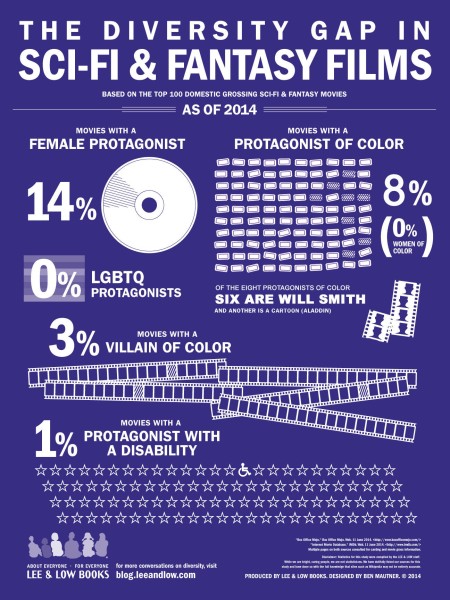
The Diversity Gap in Sci-Fi & Fantasy Films infographic (click for larger image)
Among the top 100 domestic grossing films through 2014:
• only 8% of films star a protagonist of color
• of the 8 protagonists of color, all are men; 6 are played by Will Smith and 1 is a cartoon character (Aladdin)
• 0% of protagonists are women of color
• 0% of protagonists are LGBTQ
• 1% of protagonists are people with a disability
The following interviews with two prominent entertainment equality advocacy groups shed more light on the subject.

Marissa Lee is co-founder of Racebending.com, an international grassroots organization of media consumers who support entertainment equality. Racebending.com advocates for underrepresented groups in entertainment media and is dedicated to furthering equal opportunities in Hollywood and beyond.

Imran Siddiquee is Director of Communications at the Representation Project, which is a movement that uses film and media content to expose injustices created by gender stereotypes and to shift people’s consciousness toward change. The Representation project was the follow-up to the critically acclaimed documentary Miss Representation.
Jason Low: Do these statistics surprise you? Why or why not?
Marissa Lee: The statistics are certainly striking, especially since sci-fi and fantasy belong to a genre that prides itself on creativity and imagination. These statistics aren’t necessarily surprising, since lack of diversity in Hollywood films is a well-known problem. There have been enough studies and articles, and any moviegoer can pause to notice there is a disparity. . . . Hollywood can’t go on pretending that this isn’t a problem.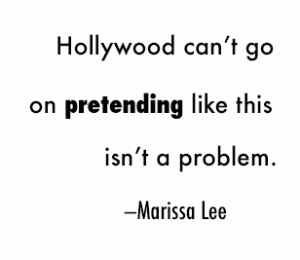
JL: Do you think the American movie-going audience would support a big, blockbuster sci-fi/fantasy movie with a diverse protagonist if a studio made it?
Imran Siddiquee: Yes, definitely. But I think an important thing to understand about Hollywood blockbusters is that they are almost never flukes; they are preordained. Sure, we have the occasional surprise indie hit, but you need a lot of money and marketing behind you to become a blockbuster. Just look at the top ten films in each of the last five years: nearly every single one had a budget of more than $100 million (a lot of them were also sci-fi/fantasy films).
Meanwhile, there hasn’t been a single film released this year starring a person of color with a budget of more than $50 million, let alone a sci-fi film, which is naturally going to be more expensive. The same goes for most of the last decade. So for anyone who might say “people just don’t watch sci-fi movies starring people of color,” or “there’s no evidence that this would work,” the truth is that we have no evidence that it wouldn’t work.
Studios take a couple of massively expensive chances every year on mostly unknown actors or directors—aka giving the Spider-Man franchise to Marc Webb and Andrew Garfield in 2012—but they just don’t take those kinds of chances on people of color. In other words, if Hollywood wanted to make a blockbuster sci-fi/fantasy film starring a woman of color, they definitely could.
ML: I think American audiences would support a film with a diverse protagonist, because we already have. One pullout statistic from your infographic is that Will Smith leads six of the top 100 big sci-fi/fantasy films. His race wasn’t a huge impediment to box office success and may have, in fact, been part of what made him all-American and relatable. That was back in the late 1990s, but since then, Hollywood hasn’t tried to find a new Will Smith. This is kind of ironic, given that Hollywood likes to stick to formulas and sequels! They could push forward another actor—or actress—of color with Smith’s charisma. They haven’t.
The American movie audience supports any movie that Hollywood successfully markets well, especially—but not always—if the film is well produced. Hollywood has managed to market some weird stuff, like a tentpole movie about talking teenage turtle martial artists, or cars that change into space robots, and so on. I don’t buy that when it comes to marketing diverse leads, suddenly this giant industry can’t do it.
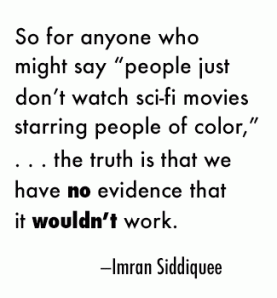 I’d be interested in seeing how many of these top 100 grossing sci-fi and fantasy films star non-human leads. I wonder if there are more films with non-human leads than minority human leads on the list!
I’d be interested in seeing how many of these top 100 grossing sci-fi and fantasy films star non-human leads. I wonder if there are more films with non-human leads than minority human leads on the list!
(Side note: Does the infographic count Keanu Reeves as white or as a person of color? I think he has more than one movie on this list given The Matrix trilogy…)
Editorial note: Yes, Keanu Reeves is counted as a PoC and did make the list for The Matrix. The second Matrix film, The Matrix Reloaded was the only installment of the trilogy to make the top 100 list.
JL: What challenges have you faced or seen peers facing as a woman/person of color, etc.?
ML: There are films with built-in audiences that Hollywood still insists on whitewashing, which has a very adverse effect on actors of color. Let’s be honest, audiences would have still flocked to see The Hunger Games or Twilight if characters like Katniss or Jacob had been cast with people of color as they were written in the books. An actor with a disability could have played the protagonist in Avatar—if we have the technology and imagination to animate a fanciful world populated by blue cat people, we could have cast an actor with a disability similar to the lead character’s in that role. As a result of these casting decisions, up and coming actors from underrepresented groups were deprived of career exposure from being a part of these established franchises, making it harder for Hollywood ever to try and launch a new franchise with an actor from an underrepresented group.
Every single Marvel Studios movie has centered around a presumably straight, white, male protagonist, even if white women (mostly love interests) and men of color (support roles) have played roles in the film. The franchise is a box office juggernaut and has a ton of movies on this list, but we’ve gotten two to three movies about each of the men on the Avengers and there’s yet to be a film about Black Widow. Both of Marvel’s ensemble films—The Avengers and Guardians of the Galaxy—trimmed down the superhero teams for their film adaptations, and the women characters, save for one, were the first to be cut. Most moviegoers will never know that women of color and LGBTQ characters were cut from Guardians of the Galaxy, but audiences will get to relate to the talking raccoon and the talking tree.
More recently, the Divergent franchise cast Naomi Watts to play a character who was a woman of color in the books. It’s a supporting role for an already established franchise, and for whatever reason the production still couldn’t bring themselves to cast an actor of color.
Trends that fans have noted in the media include that in big blockbuster sci-fi and fantasy films, the presence of a straight, white, able-bodied, cis male in some central role in the story is almost guaranteed, while the presence of characters with “minority” identities (e.g. LGBTQ folks, people of color, people with disabilities, women, etc.) is not. Even when a character who isn’t a straight, white cis male is centered in a story, there’s probably a straight, white, cis male character playing second, if not lead, billing. For example, while we can reasonably assume that the next few Star Trek and Star Wars movies will have some diverse characters, we can guarantee that at least one of the leads will be a straight, white man. If The Hunger Games or Twilight had cast actors of color for Katniss or Jacob, there would still have been plenty of lead roles filled by white actors. DC is including Wonder Woman in an upcoming movie, but the film will also feature Batman and Superman.
This means that someone with a lot of intersecting privileged identities (especially straight, white men) will always be able to walk into a multiplex and find a sci-fi/fantasy movie starring someone who shares those identities. If you have a lot of marginalized identities, then representation is a sometimes thing, never a solid guarantee. There is a very small but vocal minority of people who want to maintain this status quo, and Hollywood seems to cater toward them due to institutionalized racism, fear, and habits. But there are just as many, if not more, people who are willing to support, vociferously, films with diverse leads. I wish our money was as good as theirs.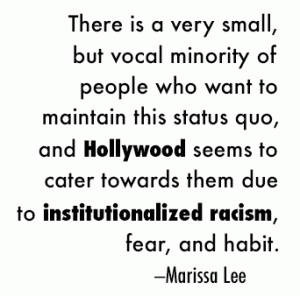
JL: How can consumers encourage more diversity in movies?
IS: Avoid buying tickets to films which clearly rely on stereotypes or demeaning portrayals of people based on gender, race, class, age, sexual orientation, ability, or circumstance. And anytime you do watch a film, give it The Representation Test afterward. The test grades films on their inclusiveness pertaining to all those above categories. When a movie scores really low on the test, use #NotBuyingIt on Twitter to let the filmmakers and all your friends know how you feel. Since so much of this industry is based on money, this is one way we can express our discontent and get the attention of the studios.
ML: Media literacy is a huge start. As media consumers, we should feel empowered to critique the media we consume, and to decide what media we choose to consume. Beyond helpful steps like going to see movies that feature diverse leads, it’s just as important to start conversations in our own communities and with our friends and family (the people we consume media with!) to raise awareness about diversity and representation. Even if we don’t go to see movies that whitewash or exclude or present discriminatory content, people we know will. One way we can help change things is by continuing to start conversations. We need to create an environment where it is safe to criticize popular franchises for lacking diversity. We also need to keep drowning out the malcontents who cannot even handle actors of diverse backgrounds in supporting roles. Social media has really knocked down barriers when it comes to communicating our opinions with Hollywood brass. It’s also given us several spaces where we can discuss the media we consume with our friends and family. In addition, the internet has really changed how we access and consume media. There are Kickstarters and indie channels and online comics and other outlets so we don’t have to be reliant on big production studios or publishers as our only sources of entertainment.
JL: How close or far do you think we are from getting these statistics to change?
IS: When you’re talking about representation that is this low, it’s hard to go anywhere but up. For instance, 0% for women of color in top sci-fi films means I’m being honest when I say things will certainly improve soon, but that’s not saying much. I think we are pretty far away from true equality, or a cinema that reflects and includes the broad diversity of human experiences in the real world.
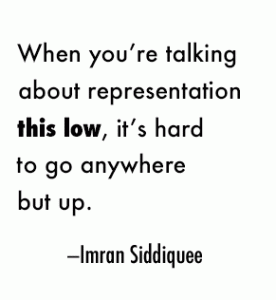 Too many wealthy, white men still run Hollywood, and their decisions still have too much power. As I mentioned earlier, these kinds of movies are very expensive, and so it’s hard for independent or upstart filmmakers to break through or compete.
Too many wealthy, white men still run Hollywood, and their decisions still have too much power. As I mentioned earlier, these kinds of movies are very expensive, and so it’s hard for independent or upstart filmmakers to break through or compete.
That being said, the slight increase in success for white women in blockbuster sci-fi movies, such as Gravity, The Hunger Games, and Divergent, means change is possible. And it’s hard to overstate the importance of the Oscar wins for 12 Years a Slave last year, because while it wasn’t a blockbuster, it is a film that everyone in the industry now knows about and has probably seen. And the whole reason we’re even talking about representation in movies right now is because we know how much seeing different experiences on screen can impact people’s real world thoughts and attitudes. So films like 12 Years a Slave are part of the gradual shifting of consciousness that has to happen in Hollywood to get to a point where studios are consistently greenlighting big-budget films starring people of color.
ML: As budgets for tentpole science fiction and fantasy movies have soared, studios have been more reluctant to take a chance on actors or characters that they perceive as risks. Because people of color and women are also already more likely to consume movies than white people and men, maybe they don’t feel an incentive to change what they are doing because, from their perspective, minorities are perfectly willing to watch films starring white guys. Hollywood is pretty stubborn, especially when it comes to tentpole movies. We are seeing more diversity in television, particularly in children’s television, as well as in online content. The establishment will change when someone influential in Hollywood decides to take the risk and make an effort to diversify their film offerings. The stats in this infographic are focused on profit, not art. For things to change, Hollywood needs to believe that diversity can be profitable.
***
This is not an isolated incident, but a wide reaching societal problem.
Read more Diversity Gap studies on:
The Academy Awards
The Tony Awards
The Emmy Awards
The children’s book industry
The New York Times Top 10 Bestseller List
US politics
Further resources on how to teach content and visual literacy using Lee & Low Books’ infographics series on the Diversity Gap:
Using Infographics In The Classroom To Teach Visual Literacy
CONTACT: For more information or to request permission to reprint, please email hehrlich[at]leeandlow[dot]com
Filed under:
Diversity, Race, and Representation,
Guest Blogger Post,
The Diversity Gap Tagged:
African/African American Interest,
Asian/Asian American,
diversity,
Latino/Hispanic/Mexican,
LGBT,
Middle Eastern,
Multiracial,
Native American,
Race issues,
Science Fiction/Fantasy,
whitewashing 


By:
jilleisenberg14,
on 7/1/2014
Blog:
The Open Book
(
Login to Add to MyJacketFlap)
JacketFlap tags:
Reading Aloud,
parents,
Educators,
bilingual education,
reading comprehension,
hispanic heritage,
Educator Resources,
Latino/Hispanic/Mexican,
dual language,
ELA common core standards,
ELL/ESL and Bilingual Books,
Add a tag
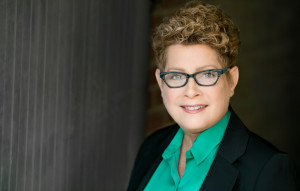
Peggy McLeod, Ed. D. is Deputy Vice President of Education and Workforce Development at the National Council of La Raza (NCLR).
 Today we are featuring one of First Book’s celebrity blog series. Each month First Book connects with influential voices who share a belief in the power of literacy, and who have worked with First Book to curate a unique collection that inspires a love of reading and learning. All recommended books are available at deeply discounted prices on the First Book Marketplace to educators and programs serving children in need. Peggy McLeod, Ed. D. the Deputy Vice President of Education and Workforce Development at the National Council of La Raza (NCLR), writes on engaging Latino families and children in reading and learning.
Today we are featuring one of First Book’s celebrity blog series. Each month First Book connects with influential voices who share a belief in the power of literacy, and who have worked with First Book to curate a unique collection that inspires a love of reading and learning. All recommended books are available at deeply discounted prices on the First Book Marketplace to educators and programs serving children in need. Peggy McLeod, Ed. D. the Deputy Vice President of Education and Workforce Development at the National Council of La Raza (NCLR), writes on engaging Latino families and children in reading and learning.
Any student who has parents that understand the journey from preschool to college is better equipped to navigate the road to long-term student success. While parent engagement is critical to increasing educational attainment for all children, engaging Latino parents in their children’s schooling has typically been challenging – often for linguistic and cultural reasons.
The National Council of La Raza’s (NCLR) parent engagement program is designed to eliminate these challenges and create strong connections between schools, parents, and their children. A bilingual curriculum designed to be administered by school staff, the Padres Comprometidos program empowers Latino parents who haven’t typically been connected to their children’s school. Many of the parents the program reaches are low-income, Spanish-speaking, first and second generation immigrants. Through Padres Comprometidos, these parents gain a deeper understanding of what the journey to academic success will be like, and how they can play a role in preparing their children for higher education. Prior to participating in the program, not all parents expected their children to attend college. After the program, 100% of parents indicated that they expected their children to attend college.
Much of Padres Comprometidos success rests on the program’s ability to address language and culture as assets, rather than as obstacles to be overcome. This asset building strategy extends to NCLR’s partnership with First Book. Together, we’re working to ensure Latino children of all ages have access to books that are culturally and linguistically relevant, books they need to become enthusiastic readers inside and outside of the classroom. Click here to access the three parent engagement curricula developed by NCLR—tailored to parents of preschool, elementary and secondary school students.
Below you will find a few tips and titles that can help you engage families and get children – and their parents and caregivers – reading and learning.

La Llorona
1. Find ways to connect stories that parents know about to help them engage in reading and conversation with their children. This Mexican folktale can open that door: La Llorona .
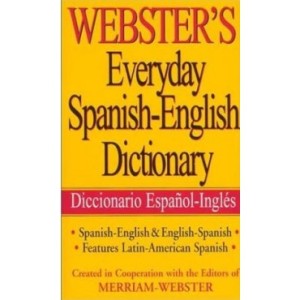
Spanish-English Dictionary
2. Keep an English/Spanish dictionary handy to use when you have a parent visiting or to give away to a parent or caregiver who needs it. It will show them that you’re making an effort to engage in their language of comfort, such as Webster’s Everyday Spanish-English Dictionary.

The Storyteller’s Candle
3. Learn about the children you serve and their heritage, and identify books that will affirm them. This Pura Belpré award winner is actually about Pura Belpré, the first Latina (Puerto Rican) to head a public library system: The Storyteller’s Candle.

Grandma and Me at the Flea
4. Share books that include some of the everyday experiences of the children and neighborhoods you serve, like this story highlighting the value of community and family: Grandma and Me at the Flea.

My Colors, My World
5. Bilingual books provide family members and caregivers the opportunity to read the same books their children are reading, but in their language of comfort. Families will love reading about all the colors of the rainbow in English and Spanish: My Colors My World.
Sign up with First Book to access these and other great titles on the First Book Marketplace.
Filed under:
Educator Resources,
ELL/ESL and Bilingual Books Tagged:
bilingual education,
dual language,
Educators,
ELA common core standards,
hispanic heritage,
Latino/Hispanic/Mexican,
parents,
Reading Aloud,
reading comprehension 

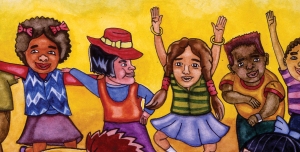
Cinco de Mayo (Spanish for May Fifth) is a day celebrated in the United States and Mexico to commemorate the Mexican Army’s victory over the French Army during the Battle of Puebla. In Puebla, Mexico, it is referred to as “El día de la batalla de Puebla” (The Day of the Battle of Puebla). This day was started by Mexican Americans in the days of the American Civil War as a day to commemorate democracy and freedom.
The Mexican Army, led by General Ignacio Zaragoza, defeated the French Army’s forces of 8000 men—then considered the strongest military in the world—with only 4500 men!
Though this day is commonly mistaken to be Mexico’s Independence Day in the US, Mexico celebrates its independence September 16. Cinco de Mayo is a holiday in Puebla, Mexico; most businesses are closed on this day.
Interestingly, Cinco de Mayo is celebrated more widely in the United States than Mexico! It’s a celebration started by Mexican Americans that later spread to Mexico. In the US, Cinco de Mayo has evolved beyond its origins to become a wider celebration of Mexican culture and heritage in the United States.
Filed under:
Celebrations,
Holidays Tagged:
History,
holidays,
Latino/Hispanic/Mexican 


By:
Hannah,
on 4/12/2014
Blog:
The Open Book
(
Login to Add to MyJacketFlap)
JacketFlap tags:
Latino/Hispanic/Mexican,
Día de los niños/Día de los libros,
Curriculum Corner,
English-Spanish,
libros en Español,
Reading Aloud,
parents,
bilingual books,
Read Aloud,
guest blogger,
ell,
bilingual,
teaching resources,
bilingual education,
reading comprehension,
Add a tag

Jennifer Brunk has been teaching Spanish and English learners from preschool to university level for over 20 years. She re sides in Wisconsin where she raised her three children speaking Spanish and English. Jennifer blogs about resources for teaching Spanish to children on Spanish Playground. The following post is reprinted with permission from her original post at Spanish Playground.
sides in Wisconsin where she raised her three children speaking Spanish and English. Jennifer blogs about resources for teaching Spanish to children on Spanish Playground. The following post is reprinted with permission from her original post at Spanish Playground.
Research has shown that reading to children helps them learn vocabulary and improves listening comprehension skills. As a parent or teacher, you are probably convinced of the value of reading to your child in Spanish, but how should you do it to promote language development?
First, it is important to keep in mind that above all reading should be enjoyable. We want to create positive associations with reading in any language. So, use these strategies and add plenty of silliness, snuggling, or whatever makes your child smile.
1. Identify core vocabulary in the story. If there are words that are central to the story that your child does not know, teach them first or make them clear as you read by pointing to the illustrations or using objects.
2. Use illustrations, objects, gestures and facial expressions to help kids understand new words. Choose stories with a limited number of new vocabulary words and a close text-to-picture correspondence.
3. Simplify the story if necessary. It is fine to reword or skip words or sentences. As your child becomes familiar with the story and acquires more vocabulary, you can include new language.
4. Read slowly. Children need time to process the sounds, connect them with the illustrations and form their own mental images.
5. Pronounce words as correctly as possible. To develop listening comprehension skills and learn new vocabulary, children need to hear correct pronunciation and natural rhythm. If your Spanish pronunciation is a work in progress, take advantage of technology. Look for books with audio CDs and ask a native speaker to record stories. At first, listen to the story with your child and take over reading when you are confident of the pronunciation.
6. Engage your child with the story by providing different ways for her to participate.Ask questions that can be answered by pointing or say a repeated phrase together. You can also give your child a toy or object that she can hold up each time she hears a key word.
7. Read the same story over and over. Repetition is essential to language learning.
8. Relate the story to your child’s life by drawing parallels as you read: Tiene un perro. Nosotros también tenemos un perro. As you go about your daily routines, refer to stories you have read.
9. Use puppets or figures to act out stories when you are playing with your child. Dramatizing the story adds movement to enhance learning and provides essential repetition of the language in context.
10. Do activities that expand on the language in the book. Look for songs, crafts or games with related vocabulary and structures.
 Visit Spanish Playground for more great resources for teaching Spanish to children, and don’t forget that Dia de los niños/ Día de los libros is in just a few weeks! What are you doing to celebrate? What are your favorite books in Spanish to read aloud?
Visit Spanish Playground for more great resources for teaching Spanish to children, and don’t forget that Dia de los niños/ Día de los libros is in just a few weeks! What are you doing to celebrate? What are your favorite books in Spanish to read aloud?
Filed under:
Curriculum Corner,
guest blogger Tagged:
bilingual,
bilingual books,
bilingual education,
Día de los niños/Día de los libros,
ell,
English-Spanish,
Latino/Hispanic/Mexican,
libros en Español,
parents,
Read Aloud,
Reading Aloud,
reading comprehension,
teaching resources 


By:
Jason Low,
on 9/18/2013
Blog:
The Open Book
(
Login to Add to MyJacketFlap)
JacketFlap tags:
Emmy Awards,
Race issues,
Multiracial,
Middle Eastern,
Latino/Hispanic/Mexican,
The Diversity Gap,
History,
diversity,
guest blogger,
Native American,
African/African American Interest,
Add a tag
Publishing diverse children’s books for more than two decades has given us a unique perspective when it comes to diversity. While our mission is to bring more diverse books to children, we hope our efforts as activists keep the wider conversation on race and inequality in the spotlight. Our previous Diversity Gap studies on the Tony Awards and the children’s book industry revealed a disturbing trend in ethnic and gender representation. We decided to focus on the television industry next.

Emmy Awards infographic (click for larger image)
Our Diversity Gap study on the Emmy Awards was the logical choice for objectively looking at the small screen. Since the Emmys will be presented on September 22, 2013, we collected data to see if a diversity gap exists in television. See our infographic above for Emmy related facts like:
- No woman of color has ever won an Emmy Award for Best Actress in a Drama Series
- In the last twenty years, winners in the Best Director of a Comedy Series were 100% white and 95% male
- An African American woman has not been nominated for lead actress in a Comedy Series since The Cosby Show (1986)
We implemented the methodology we have used previously, with the help of the Writer’s Guild of America West, and we were fortunate to have the opportunity to speak with two talented writer/actors. Their combined insights into the mechanism behind making television illuminate why the lack of diversity in casting and writing remains a very real, very complex problem.

Luisa Leschin definitely believes in the richness of diversity. She has enjoyed four very successful careers: ballet dancer, actress, voice-over artist and television script writer. Her writing credits include The George Lopez Show and Everybody Hates Chris. She is currently developing a children‘s sitcom pilot with EOne Entertainment with a theme of healthy living and is writing a pilot about Latino millennials called Homies.
 Kelvin Yu is a Taiwanese-American writer currently working on the Fox animated series Bob’s Burgers. A Los Angeles native, Yu studied theater and communications at UCLA. His acting credits include Milk, Star Trek, Studio 60 On The Sunset Strip, and The Shield. He also has a small white dog named Yuki who used to live in New York. Neither of them are fixed.
Kelvin Yu is a Taiwanese-American writer currently working on the Fox animated series Bob’s Burgers. A Los Angeles native, Yu studied theater and communications at UCLA. His acting credits include Milk, Star Trek, Studio 60 On The Sunset Strip, and The Shield. He also has a small white dog named Yuki who used to live in New York. Neither of them are fixed.
Luisa, what types of roles were you being cast for when you were an actress?
LL: I was lucky enough to be a working actress during the 1980s and early 1990s. I started my career in New York, where I studied with Uta Hagen, a legendary actress and teacher. I speak un-accented English, but judging from my auditions, I soon realized that I better work on my Mexican, Cuban, Guatemalan, Colombian, and Puerto Rican spitfire accents because those were the only roles for which I was being considered. I remember walking onto the set of Hill Street Blues, where I was playing the pregnant girlfriend of a gang member. We had just been arrested. My fellow “actor” introduced himself to me and asked me how many times I had been arrested, because he’d been arrested twice! Toward the end of my on-camera career, I did a “role-count” and discovered that I had played a pregnant woman (in various stages of delivery) no less than six times, hookers, maids, gang-girlfriends, and as I got older, gang-girlfriend’s mothers . . . and not much else.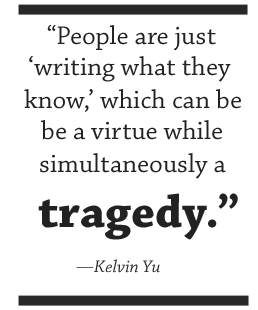
Kelvin, in our initial conversation you said you felt that as an actor you have resigned yourself to always playing second banana—that you would never appear as a main character in a TV show. You attributed this to a standard of beauty. Could you elaborate on this for us?
KY: I may have used the word “resigned” but I think, more accurately, as an Asian American actor you just come to understand the market place as it is. That’s not to say that you don’t hope it could someday change, but you understand that American audiences are not generally even ready for a female lead most of the time, so it is unlikely they will mass-consume a television show or a studio feature with an Asian American carrying the story. That said, this year we’ve seen Mindy Kaling and Ken Jeong take on huge projects that are viewed by millions of people. But these are, of course, the exception rather than the rule.
As I said before, it’s not entirely an issue of race either. I don’t think Dan Devito had any illusions in Romancing the Stone that he was gonna get to kiss Kathleen Turner. The paradigm of the American hero is, in the main, a handsome white dude, say, six feet tall—and that’s just how it is. I truly feel though, at the end of the day, audiences are going to connect with the best storytelling. We’ve seen that movie goers will champion protagonists in every shape, color, or form (even a talking pig!) if the storytelling is honest and resonant. So in some ways, I just challenge Asian American writers, producers, and directors to introduce great stories that feature different types of protagonists. It wouldn’t be fair or realistic to charge other people to tell your stories. People are just “writing what they know,” which can be a virtue while simultaneously a tragedy.
Luisa, you founded the comedy troupe Latins Anonymous. Tell us the goal of Latins Anonymous and how this led to you become a writer.
LL: The resulting frustration of having a demo reel that was a hit parade of stereotypes led me to join forces with three other Latino actors who were in the same boat. We knew that as actors we were powerless to effect change from the stage. We just didn’t have the voice to do it. The real power came from higher up—the writers and producers. So that’s why I embarked on a writing career, to help change how Latino roles were written and perceived, and also just to get more Latino actors in front of the camera. Ironically, this move pretty much killed my acting career because casting directors who came to see our show skewering stereotypes were too embarrassed to offer us those same stereotypical roles.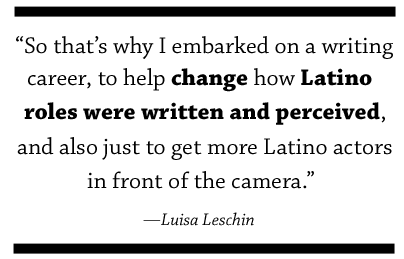
Kelvin, you attended college at UCLA, where the number of Asians make up 49% of the student population. Yet you mentioned that you are the only person of color in a thirteen person writing team. Why doesn’t the density of Asians living and working in Southern California amount to a larger representation of Asians in decision-making roles in TV?
KY: Don’t know. I know for a FACT that Asian Americans love to consume media—movies, television, video games, social media, all of it—so their lack of representation over the past several years is probably a combination of factors including cultural emphasis in different fields, a lack of avenues within the industry, and some level of systemic prejudice (particularly in the past).
However, I do think this is about to change big time. I think in the next few years you will see a flood of Asian content creators. Some of that is simply the rapidly closing cultural gap that social media and the internet are facilitating. Young Asian writers and actors and directors are growing up seeing Ang Lee and Justin Lin and Wong Kar Wai and Zhang Yimou win Oscars and BAFTAs. The world, for better or for worse, is remarkably smaller than it was a decade ago and audiences are more open, even hungry, for unique voices. I also think new media renders many of those past obstacles powerless against the thousands of outlets for Asian American creativity. For instance, even if your stern Korean father wants you to become a doctor, he can’t really stop you anymore from making small movies with your iPhone and cutting them with some app. People can write, shoot, edit, and even distribute content from a $300 laptop. How was an Asian American teenager supposed to do that in 1990? Not to make Asian parents seem like the only barrier, and also not to make them seem all like Kim Jong Eun. I just think we’re about to see an influx of new voices and, thus, new stories. Which is very exciting.
Luisa, during our conversation you mentioned “that there is a system” in place to break into writing for television. Describe for us what that system is and what are some of the hurdles involved with addressing the problem of the diversity gap in TV programs.
LL: We all know the famous quote by William Goldman: “In Hollywood, no one knows anything.” And we also know that many roads lead to Rome. . . . So, having stipulated that, I’m talking about the established network system. If you manage to get in on the ground level as a staff writer or story editor and then move up the ladder to senior story editor, producer, co-producer, and ultimately co-executive producer you will then become a known entity to the networks. At this point the powers that be feel confident that you have experienced firsthand about how TV shows are written and run. The network is willing to listen to show ideas from you, willing to consider ordering a pilot from you, because they know you have put in your time working under showrunners they trust and that you have experience on how things are done. This is the path that most showrunners have taken to rise to the position where a network trusts them to run a multi-million dollar show.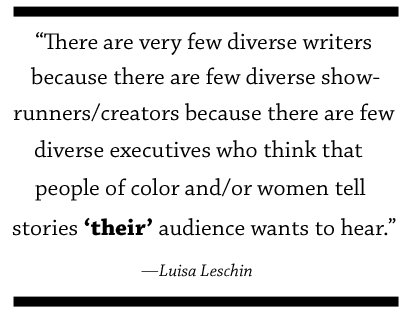
Which brings us to the biggest problem facing us in trying to narrow the diversity gap. There are very few diverse writers because there are few diverse showrunners/creators because there are few diverse executives who think that people of color and/or women tell stories that ”their” audience wants to hear. Certainly there are other ways of breaking into television writing, especially with all the new media platforms, but ultimately there are no shortcuts for putting in the time and learning the workings of television from the bottom up.
Kelvin, what are some of the factors that may keep white writers and producers from taking a chance on casting or writing more characters who are people of color into TV shows?
KY: I honestly think most writers just write what they know. Particularly in TV, which is by definition on a deadline, it’s just not going to be your instinct to pitch a story about a Pakistani family if you have never had any experiences with Pakistani families. Nor do I blame writers and producers for remaining within a personal wheelhouse of stories that reflect their particular vantage point on the world. Every once in a while, you get an Ang Lee or a Coen Brothers—storytellers who find a way to turn something quite foreign to them into something deeply personal. But I think most of us, when given that rare chance to tell a story, want to tell the stories we dreamed of sharing with the world. Our own stories. And that’s okay. That’s not just okay; that’s good. So the issue is, how do we get more eclectic people into the room? How does the face of TV writing start to look more like the face of America?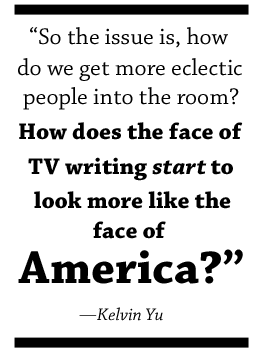
Luisa, you worked on The George Lopez Show, which aired for five seasons. From your description of the system, how did a show like this get made in the first place?
LL: It took a movie star, an established showrunner of multiple hit shows and an exceptional talent. At the time, Sandra Bullock had a development deal at Warner Brothers. Someone told her about stand-up comedian George Lopez and she and showrunner Bruce Helford (Creator of Norm, The Drew Carey Show, and Anger Management) went to see his show. Sandy fell in love with George’s talent and told Warner Brothers this was the show she wanted to develop. It took a lot of pull and star power to get the show on the air.
Everyone always has that one great idea for a pilot. But it’s seldom about the idea. All you have to do is look at most hits on TV. Cosby, a show about a family; Seinfeld, a show about nothing; Friends, six friends sitting on a couch. The salability of a pilot really rides on the team behind it. Who is the talent big enough to carry a show that has broad appeal for middle America? And who will be writing and running the show? This is why the same dozen showrunners get pilot after pilot every season. (Can you say Chuck Lorre? Bill Lawrence?) It’s because they have a track record in the network system and executives know they can deliver a show.
Luisa, you have done considerable work on some successful sitcoms over the years. Are there shows that you have worked on, or actors and actresses, who have been overlooked by the Emmy Awards?
LL: Yes! Every show I have worked on had brilliant actors who should have been at least nominated to receive an Emmy: George Lopez, Constance Marie, Belita Moreno from The George Lopez Show; Terry Cruise, Tichina Arnold, both from Everybody Hates Chris. Too often shows that feature diversity are overlooked by voters of the Academy. I don’t believe it’s any kind of conscious bias. Having been a judge for a few award shows myself, I discovered that I was more favorably inclined to a show if I had already watched the show, if I was familiar with the characters or if I might have already seen the nominated performer or episode. In short, I was already a fan. The sad fact is that most judges in the Academy are not diverse and may not be watching shows that feature diversity and/or diverse characters.
—
One thing worth noting about the 2013 Emmy Awards: Kerry Washington is nominated for best actress in a drama for Scandal. If she wins, she will be the first actress of color to win an Emmy Award for a drama in the sixty-five year history of the award! The fact that she is nominated at all is a testament to Shonda Rhimes’s style of ethnically inclusive casting and writing. Ms. Rhimes is essentially the embodiment of what Luisa Leschin describes as the television system for breaking into writing. Ms. Rhimes worked her way up the ranks, paid her dues, and became a showrunner. Her version of television presents a real world example of what TV shows could look like: ethnically and gender inclusive, entertaining, and . . . successful.
Our Emmy Award study, much like our studies on the Tony Awards and the children’s book industry show that the diversity gap is a widespread, societal problem that we all have a responsibility to fix.
Filed under:
guest blogger,
The Diversity Gap Tagged:
African/African American Interest,
diversity,
Emmy Awards,
History,
Latino/Hispanic/Mexican,
Middle Eastern,
Multiracial,
Native American,
Race issues 


By:
Jason Low,
on 3/13/2013
Blog:
The Open Book
(
Login to Add to MyJacketFlap)
JacketFlap tags:
Middle Eastern,
Asian/Asian American,
Latino/Hispanic/Mexican,
Awards,
Book News,
diversity,
first book,
LGBT,
Native American,
African/African American Interest,
Bellringers,
Race issues,
Multiracial,
Dear Readers,
Add a tag
In a groundbreaking announcement, First Book, a non-profit social enterprise launched the Stories for All Project. The project’s aim is to introduce a significant number of multicultural books into the hands of low-income children. LEE & LOW was chosen as one of two publishers to be a part of this endeavor and receive a $500,000 award.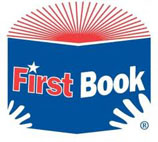
For us the presence of this project further addresses the fact that diverse books are a necessity. Making multicultural books available to low-income families is a step toward addressing the chasm between people who believe these books are important to actually making the books available to the children who need them.
For years I have been involved in conversations with librarians and educators on the subject of how we need more diverse books. However, there is this strange disconnect where people continue to point out the lack of diverse books without doing the most obvious thing, which is supporting the companies that publish these books in the first place. The support is simple. It involves buying the books. It also involves telling people about the books and recommending them to buy the books. The more this happens the more books we can publish.
What First Book has done is monumental in supporting multicultural books. It is a bold statement that I hope is just the beginning. An infusion of this many diverse books increases the chances of a child being able to see a face like his or her own staring back at them from the pages of a book. This moment of recognition for a child will create a profound experience that will be forever associated with the act of reading. This powerful relationship to books is one that they will hopefully cultivate for the rest of their lives.
On behalf of everyone at LEE & LOW I want to thank CEO Kyle Zimmer, Executive Vice President Chandler Arnold, Vice President Erica Perl, along with all the dedicated people working on the Stories for All Project. First Book’s commitment and dedication to literacy and multicultural literature is to be commended. This will be a game changer for many children who will be receiving their very first book ever.
Filed under:
Awards,
Bellringers,
Book News,
Dear Readers Tagged:
African/African American Interest,
Asian/Asian American,
diversity,
first book,
Latino/Hispanic/Mexican,
LGBT,
Middle Eastern,
Multiracial,
Native American,
Race issues 

A guest post by Summer of the Mariposas author Guadalupe Garcia McCall.
I’ve been travelling to the Rio Grande Valley in South Texas a lot these days, visiting with some wonderful librarians, sharing my story with some amazing students, and just enjoying the adventures this burgeoning writing life is affording me.
Road trips have always been a meditative time for me, a time to be thankful for the blessings in my life and ponder the rest. I listen to the silence of the road, look at the scenery, and engage in prayer. Lately, I’ve been thinking a lot about being an author and wondering if this is going to be my next career, if I will be fortunate enough to have more books published. Not that I am doubting myself, no, it is more that I am feeling so privileged I don’t want to lose myself in the awesomeness of it all. I don’t want to let it go to my head. I want to always remain true to myself, my culture, and my faith.
Last week, as we were en route to Edinburg, I was looking out of my car window, asking for a sign, when quite literally there it was, a sign—a small billboard on the side of the road indicating the location of The Shrine of Don Pedrito Jaramillo, a Texas historical landmark.
Don Pedrito was a curandero, a healer, who was buried on the outskirts of Falfurrias, Texas in 1907. He came from Jalisco, Mexico, and got so sick he couldn’t sleep for days. He cured himself by applying mud to his injured nose and was finally able to get some much needed rest. It was while he slept that God spoke to him and told him he had to help heal the sick. Tales of his miraculous healings abound within the Hispanic community, and so I told my husband we absolutely had to stop.
 So we visited the shrine and a sweet lady helped me pick the perfect candle, la vela de Santa Lucia—for personal elucidation. I lit my candle, gave thanks for this wonderful new writing career, and prayed for guidance and clarity as I embark on this path. That’s when it happened: I received a visit from a most unexpected guest.
So we visited the shrine and a sweet lady helped me pick the perfect candle, la vela de Santa Lucia—for personal elucidation. I lit my candle, gave thanks for this wonderful new writing career, and prayed for guidance and clarity as I embark on this path. That’s when it happened: I received a visit from a most unexpected guest.
It occurred just as I was about to get back in my car, when my husband stopped me and said, “Be careful, you almost closed the door on that butterfly.” I looked at the door’s edge, and there she was, a lovely mariposa. Not just any mariposa, but a brown winged, dark-speckled, many-eyed mariposa. A visitor with a message to deliver.

The Aztecs believed that mariposas were the souls of their loved ones come back to visit them, to bring tidings of hope, and to reassure them that life, however brief, is beautiful. I firmly believe that mariposa was the spirit of my mother who came to remind me that she is with me on this journey, that her loving eyes are always upon me. That I have nothing to worry about because I am being taken care of—that she along with many others are “looking out” for me.
My lovely visitor crawled onto my hand, walked up my sleeve, and just sat there, splaying and displaying her brown, many-eyed wings, as I spoke to her. Some minutes later, she sat politely by while I pulled out my phone and took four close-ups of her. Then, when I thanked her for her unexpected, but much welcomed visit, she let go of the fabric of my jacket and just flew away—reminding me that life is an adventure and I should spread my wings and brave the wind with courage and conviction as I rejoice in the abundance of my blessings.
Filed under:
Musings & Ponderings Tagged:
guadalupe garcia mccall,
Latino/Hispanic/Mexican,
Summer of the Mariposas,
Teens/YA,
Tu Books 

Today is International Day of the World’s Indigenous Peoples! According to the United Nations, the theme this year is “Indigenous Media, Empowering Indigenous Voices.” It’s nice to see indigenous groups being recognized not as ancient civilizations or oppressed minorities, but as powerful, modern communities actively working to shape their futures. To that end, I came across this video from the BBC and thought it was pretty cool:
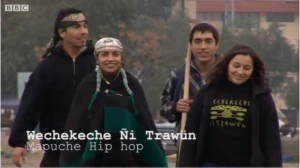
Mapuche Rap – click through to view
What a way to preserve language!
Filed under:
Musings & Ponderings Tagged:
indigenous culture,
Latino/Hispanic/Mexican,
Native American,
Power of Words,
videos 

Loved Under the Mesquite? For a limited time, we’re sharing the first three chapters of Belpré winner Guadalupe Garcia McCall’s next book, Summer of the Mariposas, out in October! Summer of the Mariposas is a YA retelling of The Odyssey about five sisters who embark on a road trip through Mexico to return a dead [...]

By:
Jason Low,
on 6/1/2012
Blog:
The Open Book
(
Login to Add to MyJacketFlap)
JacketFlap tags:
diversity,
politics,
sexism,
LGBT,
Educators,
society,
Native American,
African/African American Interest,
Musings & Ponderings,
Race issues,
Multiracial,
Dear Readers,
Asian/Asian American,
Latino/Hispanic/Mexican,
human-rights,
Add a tag
Throughout the history of the United States, equality for all people has been fought for and won time and time again. Thomas Jefferson wrote in the Declaration of  Independence ”that all men are created equal,” and over time equal rights have been gradually extended to different groups of people. However, equality has never been achieved without heated debate, despite our country’s founding principle that all people are created equal in the first place.
Independence ”that all men are created equal,” and over time equal rights have been gradually extended to different groups of people. However, equality has never been achieved without heated debate, despite our country’s founding principle that all people are created equal in the first place.
The language used to seek equality has remained familiar over time. Posters demanding equal rights (pictured) contain messages we have all seen or heard. One of my theories is that since the human life span is finite, the message of equality has to be relearned by each generation as it comes to realize that more work needs to be done.
If humans lived longer, would full equality across racial and gender lines have been acquired by now? Ask yourself: Would women suffragists from the 1920s, who so 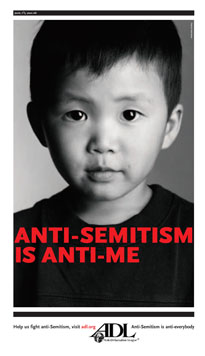 vehemently demanded the right to vote, think it was fine for African Americans to be denied this same right? It depends. My theory also includes the caveat that empathy for others does not always translate into citizens banding together for the greater good. Then again, the social evolution of the United States is progressing. This progression is the reason the language and message of equality remains relevant.
vehemently demanded the right to vote, think it was fine for African Americans to be denied this same right? It depends. My theory also includes the caveat that empathy for others does not always translate into citizens banding together for the greater good. Then again, the social evolution of the United States is progressing. This progression is the reason the language and message of equality remains relevant.
Equality is a shared goal that not everyone enjoys. Racial intolerance for one group is no different than bigotry for another. Denying equality for a particular group plays into the kind of discriminatory trap that makes no sense if one applies the very same principles of equality indiscriminately. All people are created equal, period.
The Declaration of Independence was written with the hope of possibility. Think about it—the signers of this document were declaring a new and independent country! 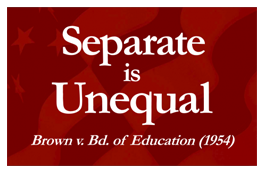 Jefferson’s words made a statement about human rights that became the foundation for a country unlike any other in the world. The signers never anticipated that their vision would eventually embrace so many different kinds of people, but that is the beauty of it. The Declaration was groundbreaking because it provided a foundation of principles and moral standards that have endured to modern times and that accommodate human evolution and its capacity for acceptance.
Jefferson’s words made a statement about human rights that became the foundation for a country unlike any other in the world. The signers never anticipated that their vision would eventually embrace so many different kinds of people, but that is the beauty of it. The Declaration was groundbreaking because it provided a foundation of principles and moral standards that have endured to modern times and that accommodate human evolution and its capacity for acceptance.
Stepping back and viewing all these posters as a whole, one could come to two conclusions. First: the human race does not learn from history. Second: humans 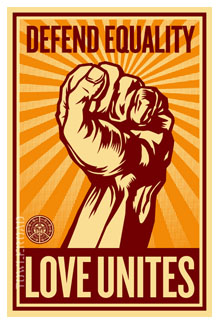 repeat the same mistakes over and over. However, I believe that the preservation and repurposing of the messages of protest in all their different forms are evidence that we do learn from history, and that we apply these tactics when the moment calls for them.
repeat the same mistakes over and over. However, I believe that the preservation and repurposing of the messages of protest in all their different forms are evidence that we do learn from history, and that we apply these tactics when the moment calls for them.
Similar to my previous posts on Race-Based Comedy and Race in Advertising, this post is a small glimpse into a bigger topic that welcomes further discussion. These subjects would be commonplace in a college syllabus, but is there any reason why we shouldn’t introduce dialogue about such issues into our daily lives? At the dinner table, instead of asking your kids how their day was at school and receiving a one-word answer, try bringing
Like dating, designing the right cover for a book can be a long, arduous process. Sometimes a cover gives off the wrong impression. Sometimes it’s too showy, sometimes it’s too dull. Sometimes a cover says all the right things, but lacks sincerity.
But sometimes, you find The One. And you just know.
That was the case with the cover of Summer of the Mariposas, coming this fall from our Tu Books imprint. Summer of the Mariposas, by Guadalupe Garcia McCall, is a YA retelling of The Odyssey set in Mexico. It follows Odilia and her sisters on their quest to return a dead man to his family (you can read an excerpt of the book here).
Because Guadalupe Garcia McCall is such a gorgeous writer (her first novel, Under the Mesquite, won the Pura Belpré Award and was a Morris Award Finalist) we wanted to find a gorgeous cover that would do justice to her work. Based on suggestions from the editor, Stacy Whitman, and Guadalupe herself, the designer came back with seven or eight different covers to start with. But when we saw this one, we knew it was perfect:
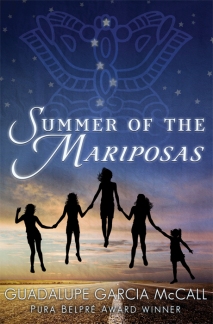
This cover is filled with small details that really capture the feeling of the story – the symbol in the sky, five stars for five sisters, the fantasy elements grounded by a very real-looking road. And yesterday the first ARCs came in, so now we can see what they look like in real life:
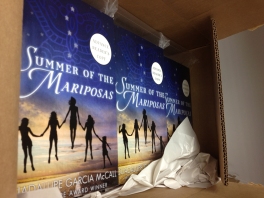
What do you think?
(Note: if you’ll be at ALA, we’ll be doing an ARC signing with Guadalupe Garcia McCall herself on Sunday morning at 10AM in booth #2436!)
Filed under:
Publishing 101 Tagged:
cover design,
guadalupe garcia mccall,
Latino/Hispanic/Mexican,
sneak peeks,
Teens/YA,
Tu Books 




By:
Hannah,
on 4/10/2012
Blog:
The Open Book
(
Login to Add to MyJacketFlap)
JacketFlap tags:
Book News,
diversity,
sneak peeks,
Science Fiction/Fantasy,
Tu Books,
Teens/YA,
Latino/Hispanic/Mexican,
Summer of the Mariposas,
mexican folklore,
national siblings day,
Add a tag
Today is National Siblings Day, so we thought it would be the perfect time to share a sneak peek of one of our most highly anticipated upcoming books: Morris finalist and Belpré winner Guadalupe Garcia McCall’s Summer of the Mariposas! Out in fall 2012 from our Tu Books imprint, Summer of the Mariposas is a YA retelling of The Odyssey in which Odilia and her sisters embark on a quest through Mexico to return a dead man to his family, and must overcome monsters from Mexican folklore as they journey home.
In the excerpt below, the Garza sisters have found a dead body in their swimming hole, and Juanita, the second eldest, has hatched a harebrained scheme to take their father’s car and return the dead man to his family in Mexico. Odilia, the eldest (and narrator of Summer of the Mariposas), is trying to trick her sisters into staying home by telling them she’ll tell their mother:
Juanita came back into the room, looking more like herself again. “You’re a lousy sister!” she yelled.
“Enough!” I finally raised my voice the way Mamá does when she’s done putting up with them. “Now go to bed before I call Mamá back and tell her what’s really going on. And you, stop cursing, or I’ll wash your mouths out with Clorox.”
To my surprise, the twins flounced off the bed. All four of my sisters marched out and down the hall to the kitchen without another word. I went out the front door, locked it, and put the spare key to the deadbolt in my pocket. There was no other set of keys in the house to that door, so if they wanted to open it again, they’d have to wait until Mamá came home or jump out a window.
The thought had barely entered my mind when I heard the unmistakable sound of a window being slid open. I turned around to look at the darkened house. The only light was in Pita’s room, which faced the front.
“You can’t back out of this! We out-vote you four to one!” Juanita screamed, her body halfway out the window.
I lifted my hand in the air, my index finger extended. “Rule Number One of the code of the cinco hermanitas: The eldest sister has the final word. Always. Good night.”
I left the yard, closing the gate behind me noisily, so they could hear me leaving even in the moonless night. Then I walked resolutely up the sidewalk toward Brazos Street. The thought of them escaping through a window made me cringe. I froze momentarily before I reached the corner, but then I realized they wouldn’t do that. They might be wild, but they depended on me for everything. If I wasn’t in on it, it usually didn’t fly. That was the beauty of following the code of the five little sisters. We really did do everything together.
Of course, Odilia’s sisters do win out in the end, and the girls end up on a road trip to Mexico, guided by La Llorona, the legendary Wailing Woman. On the way home, the sisters must overcome their tendency to bicker, join together, and defeat the magical forces of evil they meet—a witch and her Evil Trinity of monsters—so they can return home.
Stay tuned for more sneak peeks and excerpts from Summer of the Mariposas, and check out a great new interview with Guadalupe Garcia McCall on growing up bilingual and between cultures. And if you haven’t yet read Under the Mesquite, what are you waiting for?
Filed under:
Book News Tagged:
diversity,
Add a Comment
Congratulations to Juan Felipe Herrera, who has just been appointed California poet laureate! Herrera is the author of 28 volumes of poetry and other works, including several award-winning children’s books.
In honor of Juan Felipe Herrera, here’s a poem from his book The Upside Down Boy:
After a week of reading a new poem aloud to us every day
Mrs. Sampson says, “Write a poem,”
As she plays symphony music on the old red phonograph.
I think of Mama, squeeze my pencil,
pour letters from the shiny tip like a skinny river.
The waves tumble onto the page
L’s curl at the bottom.
F’s tip their hats from their heads.
M’s are sea waves. They crash over my table.
Juanito’s Poem
Papi Felipe with a mustache of words.
Mama Lucha with strawberries in her hair.
I see magic salsa in my house and everywhere.
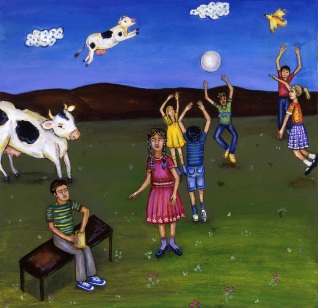
Learn more about Juan Felipe Herrera’s other books, Featherless/Desplumado and Calling the Doves/El canto de las palomas, both available or coming soon from our new Children’s Book Press imprint!
Filed under:
Musings & Ponderings Tagged:
Latino/Hispanic/Mexican,
poetry,
writing 




 0 Comments on California’s new poet laureate! as of 3/22/2012 4:02:00 PM
0 Comments on California’s new poet laureate! as of 3/22/2012 4:02:00 PM
We hope everyone had a great President’s Day! The month of February has been filled with some fascinating diversity-related stories. Here are just a few that we’ve  been following; if you’ve got more February news stories, feel free to share them in the comments below!
been following; if you’ve got more February news stories, feel free to share them in the comments below!
In a matter of weeks, Knicks player Jeremy Lin has gone from bench-warmer to star athlete. His incredible success on the court has prompted questions about whether his ethnicity had anything to do with his slow rise to the top as well as some interesting race-related memes. Ultimately, though, the most important aspect of this story may be that tons of people now have a great new role model.
New statistics show that interracial marriages in the US have hit an all-time high of 1 in 12 marriages. Experts attribute the rise to growing pools of Asian and Hispanic immigrants, and say the increase could lead to better racial relations long-term. “Mixed-race children have blurred America’s color line,” said Daniel Lichter, a sociology professor at Cornell University. Meanwhile, HBO gives a look at one interracial couple who fought for the right to marry.
to growing pools of Asian and Hispanic immigrants, and say the increase could lead to better racial relations long-term. “Mixed-race children have blurred America’s color line,” said Daniel Lichter, a sociology professor at Cornell University. Meanwhile, HBO gives a look at one interracial couple who fought for the right to marry.
Arizona legislators continue to push for a prohibition of “partisan doctrine” from Tuscon schools. Tuscon’s award-winning Mexican American Studies Program was recently shut down and several books used in the curriculum were removed from classrooms. Debbie Reese of American Indians in Children’s Literature has a comprehensive timeline of how things have played out here.
And of course it’s Black History Month! If you haven’t entered our giveaway yet, what are you waiting for?
Filed under:
Add a Comment

By:
Hannah,
on 2/10/2012
Blog:
The Open Book
(
Login to Add to MyJacketFlap)
JacketFlap tags:
Book Lists,
LGBT,
African/African American Interest,
Multiracial,
Teens/YA,
Asian/Asian American,
Latino/Hispanic/Mexican,
DiYA,
DiYA Roundups,
diversity,
Add a tag
Some of you may be familiar with Diversity in YA (DiYA), a lovely project started last year by authors Cindy Pon and Malinda Lo to bring more attention to diversity in children’s literature. During the year-long DiYA project, Cindy and Malinda were kind enough to do a roundup each month of new titles coming out that featured diversity, and they defined diversity in the following way: (1) main characters or major secondary characters (e.g., a love interest or best friend kind of character) who are of color or are LGBT; or (2) written by a person of color or LGBT author.
Since DiYA is on hiatus, Cindy and Malinda gave us their blessing to continue their monthly roundup. We all felt that it was important to keep the spotlight on diverse books, and we hope you’ll join us in that mission!
Here’s our first roundup: diverse books out this February (if you’re on Pinterest, you can follow the booklist there):
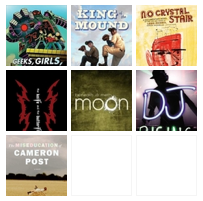
Geeks, Girls and Secret Identities by Mike Jung
King of the Mound: My Summer With Satchel Paige by Wes Tooke
No Crystal Stair: A Documentary Novel of the Life and Work of Lewis Michaux, Harlem Bookseller by Vaunda Micheaux Nelson, illus. by R. Gregory Christie
The Knife and the Butterfly by Ashley Hope Pérez
Beneath a Meth Moon by Jacqueline Woodson
DJ Rising by Love Maia
The Miseducation of Cameron Post by Emily M. Danforth
Read ‘em! Review ‘em! Share the diversity love! Please let us know if we missed any books so we can add them, and keep a lookout for next month’s roundup.
Filed under:
DiYA Tagged:
African/African American Interest,
Asian/Asian American,
Book Lists,
diversity,
DiYA Roundups,
Latino/Hispanic/Mexican,
LGBT,
Multiracial,
Teens/YA  1 Comments on Announcing Our first DiYA Monthly Book Roundup!, last added: 2/10/2012
1 Comments on Announcing Our first DiYA Monthly Book Roundup!, last added: 2/10/2012
 New Visions Award – Modeled after LEE & LOW’s New Voices Award, this award is for Science Fiction, Fantasy, or Mystery middle grade or YA novels.
New Visions Award – Modeled after LEE & LOW’s New Voices Award, this award is for Science Fiction, Fantasy, or Mystery middle grade or YA novels.


 Monica Brown is the author of several award-winning
Monica Brown is the author of several award-winning 





 instead decides to give his money to a homeless man.
instead decides to give his money to a homeless man. Passage to Freedom
Passage to Freedom
 This week, the We Need Diverse Books campaign
This week, the We Need Diverse Books campaign 







 As media coverage has intensified around the events of children crossing the U.S. border, many educators and families are wondering, “What should we tell our students?” For some children, this may be the first time they are learning of these countries. But for many others, these events may involve their own heritage or depict their families’ experiences. Using books to talk about the recent events can be an opportunity to learn about a new region and help children see the cultures and people beyond these events.
As media coverage has intensified around the events of children crossing the U.S. border, many educators and families are wondering, “What should we tell our students?” For some children, this may be the first time they are learning of these countries. But for many others, these events may involve their own heritage or depict their families’ experiences. Using books to talk about the recent events can be an opportunity to learn about a new region and help children see the cultures and people beyond these events.
 2.
2. 
 4.
4.  5.
5. 
































 So we visited the shrine and a sweet lady helped me pick the perfect candle, la vela de Santa Lucia—for personal elucidation. I lit my candle, gave thanks for this wonderful new writing career, and prayed for guidance and clarity as I embark on this path. That’s when it happened: I received a visit from a most unexpected guest.
So we visited the shrine and a sweet lady helped me pick the perfect candle, la vela de Santa Lucia—for personal elucidation. I lit my candle, gave thanks for this wonderful new writing career, and prayed for guidance and clarity as I embark on this path. That’s when it happened: I received a visit from a most unexpected guest.

 Independence ”that all men are created equal,” and over time equal rights have been gradually extended to different groups of people. However, equality has never been achieved without heated debate, despite our country’s founding principle that all people are created equal in the first place.
Independence ”that all men are created equal,” and over time equal rights have been gradually extended to different groups of people. However, equality has never been achieved without heated debate, despite our country’s founding principle that all people are created equal in the first place. vehemently demanded the right to vote, think it was fine for African Americans to be denied this same right? It depends. My theory also includes the caveat that empathy for others does not always translate into citizens banding together for the greater good. Then again, the social evolution of the United States is progressing. This progression is the reason the language and message of equality remains relevant.
vehemently demanded the right to vote, think it was fine for African Americans to be denied this same right? It depends. My theory also includes the caveat that empathy for others does not always translate into citizens banding together for the greater good. Then again, the social evolution of the United States is progressing. This progression is the reason the language and message of equality remains relevant. Jefferson’s words made a statement about human rights that became the foundation for a country unlike any other in the world. The signers never anticipated that their vision would eventually embrace so many different kinds of people, but that is the beauty of it. The Declaration was groundbreaking because it provided a foundation of principles and moral standards that have endured to modern times and that accommodate human evolution and its capacity for acceptance.
Jefferson’s words made a statement about human rights that became the foundation for a country unlike any other in the world. The signers never anticipated that their vision would eventually embrace so many different kinds of people, but that is the beauty of it. The Declaration was groundbreaking because it provided a foundation of principles and moral standards that have endured to modern times and that accommodate human evolution and its capacity for acceptance. repeat the same mistakes over and over. However, I believe that the preservation and repurposing of the messages of protest in all their different forms are evidence that we do learn from history, and that we apply these tactics when the moment calls for them.
repeat the same mistakes over and over. However, I believe that the preservation and repurposing of the messages of protest in all their different forms are evidence that we do learn from history, and that we apply these tactics when the moment calls for them.







The problem is that there are many thousands of books for educators to choose for their classes. While you are correct that a book like BUFfALO SONG can be presented to students during other months of the year, it fair to assume that without an Ethnic Heritage Month for this book, teachers are likely to choose other books and ignore it all together. But November gives this book a fighting chance to be presented to students because there is a special months just for a book like this. All in all, taking into account the many thousands of books … Ethnic Heritage Months are very useful for books written by and for a special group of minorities.
Hi Giora-
I agree with you that there are thousands of books for educators to choose for their classes (if they are given a choice at all!). Designated months for ethnic heritage and other groups create a time and space to reflect on and celebrate specific figures and contributions in history. We recognize that certain months may be the only time educators have available to infuse additional history topics and cultures into the curriculum. Thus, we are committed to the goals and legacy of Black History Month, Women’s History Month, Native American Heritage Month and more while at the same time to shining a light on a cultural group’s contributions to history and contemporary life all year round. We are always thinking about how to incorporate new thinking, perspectives, and activities into these theme- or group-specific months as well as general scope and sequence plans and multiple units within different teachers’ curricula. I agree with you that these designated months can be very useful. Indeed, these are another tool educators have to broaden the scope of diversity in the world of children’s literature and provide books that engage, inform, and excite all children. It is our hope that an educator discovers an incredible book during one of these months and further elevates it to the general curriculum or the tried-and-true read aloud bin.